What is the Manufacturing Process of plastic extrusion?
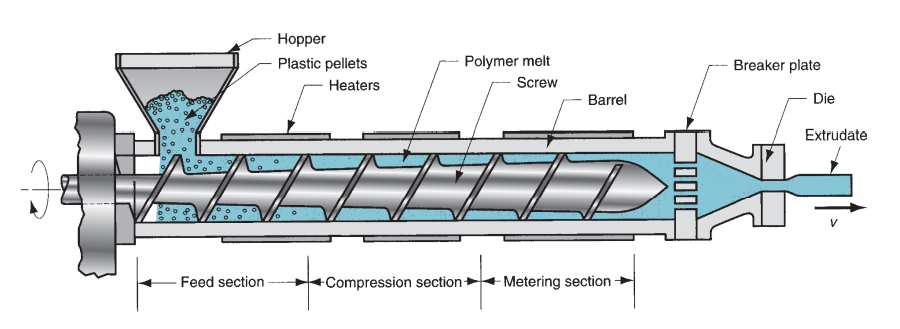
1)In the Feed Section, the raw material (polymer) in the form of granulates, travels by gravity to the feed throat and drops to the rotating screw, the rotation of the screw conveys the plastic forward through the heated barrel, in where the loose solid forward at the same time be compacted.
2)In the Compression Section, as the plastic has conveyed forward along the screw the channel depth decreases, the raw material is further compacted, while heating outside the barrel and the screw and the barrel inner wall continue to be friction shear, the material temperature rises and begins to melt, the compression section end;
3)In the Metering Section, the uniform molten plastic is extruded to the die for molding with fixed temperature, quantitative, and fixed pressure.
Please check below videos for better understanding.
Types of plastic extruders
In terms of plasticizing ability, there are two types of plastic extrusion machines(extruders) : single-screw extruders and twin-screw extruders. Single-screw extruders are mainly used for extruding soft and hard polyethylene and other thermoplastics, while twin-screw extruders have good mixing and plasticizing ability and short residence time in the extruder for material, which is suitable for powder processing. Generally speaking, the extrusion PC, PMMA, ABS profiles on the market use single-screw extruders. Twin-screw extruders are developed on the basis of single-screw extruders, and are mostly used for the granule extraction of modified raw materials and extrusion of PVC profile due to its good feeding performance, mixing and plasticizing performance, exhaust performance, and extrusion stability.
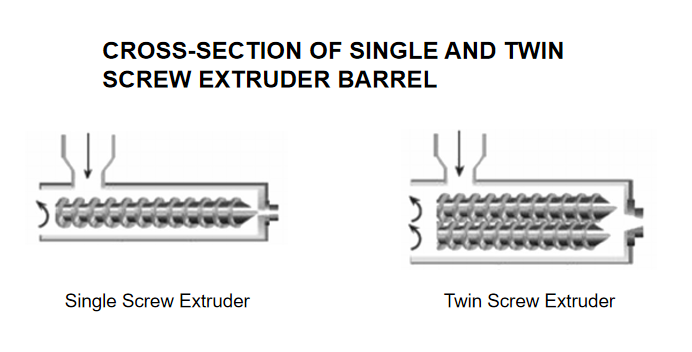
Extruder size and applications
In the market, machine size is generally measured according to tonnage, such as injection molding machine, according to the size of tonnage, there are 80T, 120T, 150T, 240T, 320T, different sizes products need to use different tonnage machine for production. However, the plastic extruders are defined according to the size of the screw diameter, there are 25 extruder, 35 extruder, 40 extruder, 50 extruder, 55 extruder, 65 extruder, 80 extruder, the larger the value, the wider the width of the profile can be produced. In addition, when choosing an extruder for plastic profile production, the length-to-diameter ratio of the screw should be considered. The length-to-diameter ratio of the screw is the ratio of the effective working length of the screw to the diameter of the screw, expressed as L/D.). The larger the L/D value, the longer the effective working length of the screw, the longer the plastic stays in the extruder at a given screw speed, and the better the plasticizing conditions of the plastic. Therefore, in general, plastic such as PET, which is with high viscosity and difficult to plasticize requires a larger L/D ratio screw; plastic like LDPE, which is low viscosity and easy to plasticize can use a smaller L/D screw. PVC, PE, ABS, PC, PMMA and other materials have different properties, their needs of screw L/D are different, so the extrusion machine can not be shared. At present, we are using more and more extruded products in the lighting industry, PC or PVC for the base of the LED Tri-proof Light, PC or PMMA for the LED Tube Light and LED Linear Light Fixture, most of their widths is within 150mm, so the production can be satisfied with 50 extruders. For Troffer, shoplight or subway and bus lighting projects, the width of the product is between 150-300mm, in that case, 65 extruders are needed to produce them.
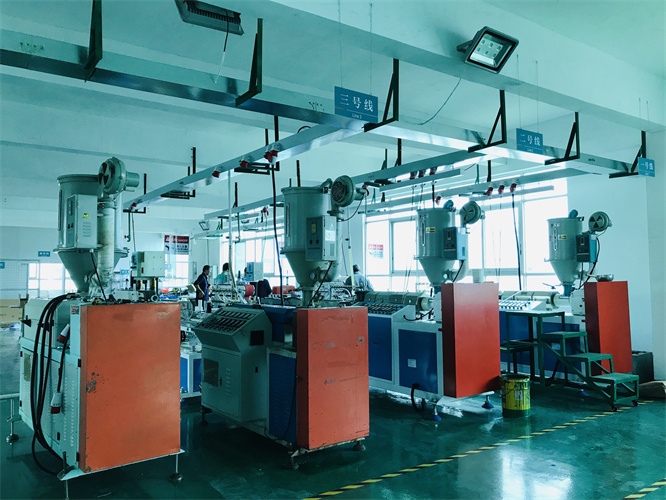
3 types of plastic extrusion cooling methods
The extrusion process has developed slowly in China, and the scope of application is relatively narrow, not comparable to the injection molding. The early use of extrusion process in China is PVC extrusion, which is what we see in our daily life, such as water pipes, wire sinks, and sewer pipes. With the development of the lighting industry in recent years, more and more extruded parts are used in lighting products, the demand becomes larger, the requirements are also improved, more and more resources are put into the development, the process has been greatly improved. According to the way how the product is cooled, there are three types pleastic extrusion cooling methods: water cooling, oil cooling, air cooling. Let`s see their advantages and disadvantages in the followings:
1)Water Cooling
As the name implies, water cooling is to cool the shaping mold by water circulation, and the speed of cooling determines the production speed of the product. This kind of cooling process is suitable for produce some simple PC diffuser, Tri-proof light lampshade, because the capacity is very high, can reach a ton a day. The biggest disadvantage is that due to the fast extrusion speed, there will be pulling lines on the product surface and the product dimensions are not stable. Moreover, when producing PMMA or PC products with thickness above 5mm, uneven cooling inside and outside will lead to uneven surface of the products. Most Chinese extrusion factories are producing plastic profile with water cooling process, which does not require high requirements operator, and the extrusion machines are relatively simple and easy to operate.
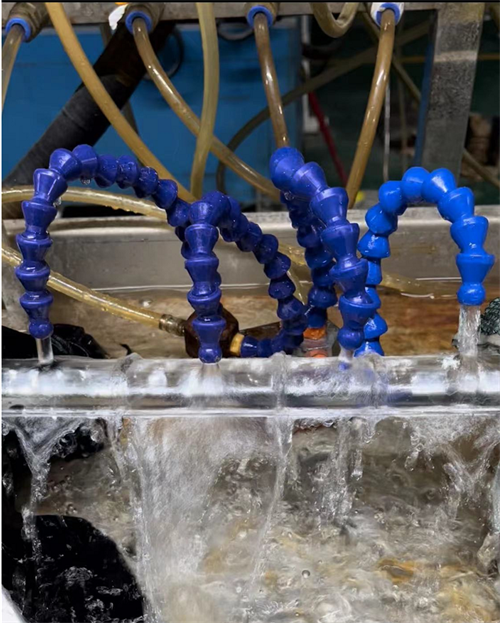
2)Oil Cooling
In simple terms, oil cooling is change the water circulation of water cooling to immersion in oil. The extruded parts coming out from the mold is immersed in oil for cooling. Conduction oil has the performance of resistance to thermal cracking and chemical oxidation, good heat transfer efficiency, fast heat dissipation and good thermal stability. Based on this property of oil, oil cooling is suitable for making thicker acrylic products, such as: rods, round tubes and other similar extruded products. The disadvantage is the cooling speed is slow, low capacity, profiles with complex structure are difficult to be produced. Not many factories in mainland China with oil-cooling process production, which was started from Taiwan, China, especially the oil used for heat conduction is special, which is difficult to buy in mainland China, coupled with the cooling machine are made in Taiwan, the operator's technical requirements are high.
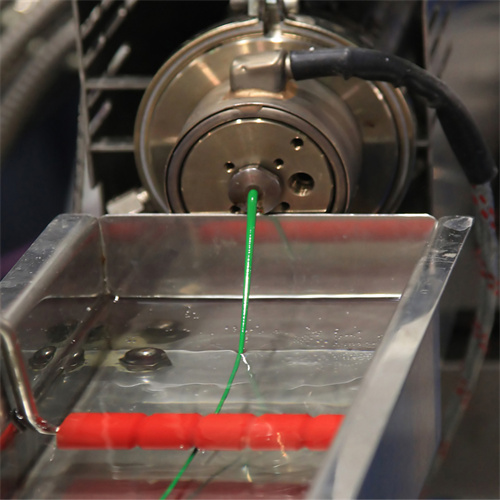
3)Air Cooling
Air cooling uses the wind to cool the extruded profiles, this cooling process originated in European countries, especially Germany. The air cooling process has high requirements for production equipment and operators, which combines the advantages of both water cooling and oil cooling processes, not only can produce complex structures profiles, but also to produce nice PMMA products, and the product dimensions during production is very stable. The only disadvantage is the capacity is not high.
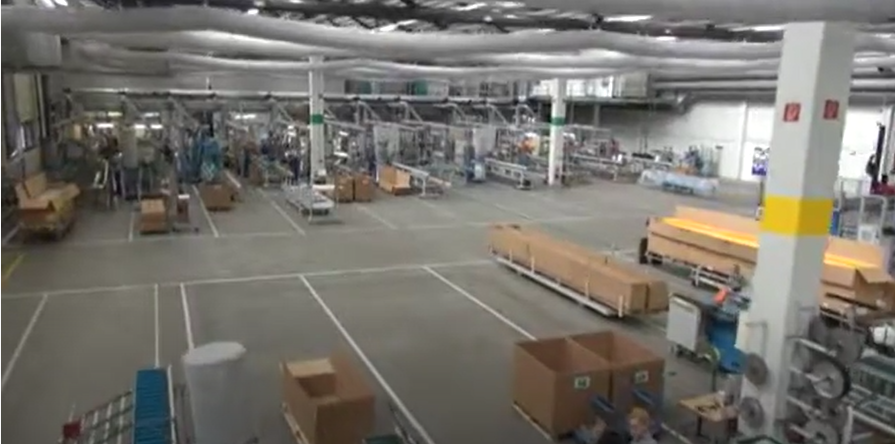


 简体中文
简体中文
